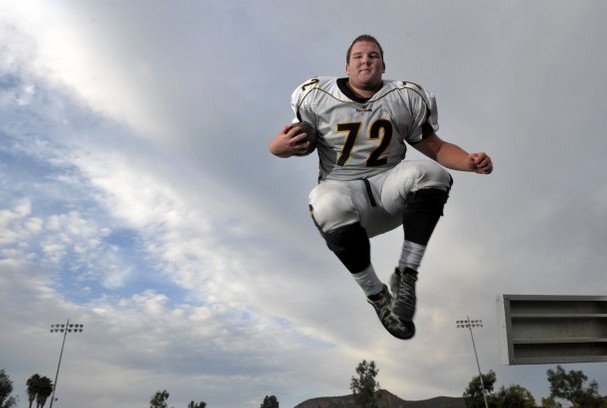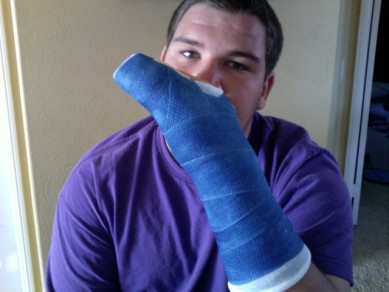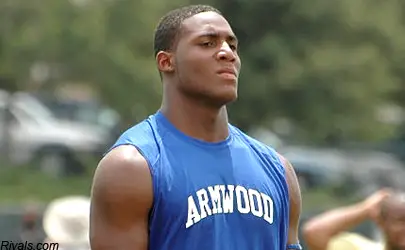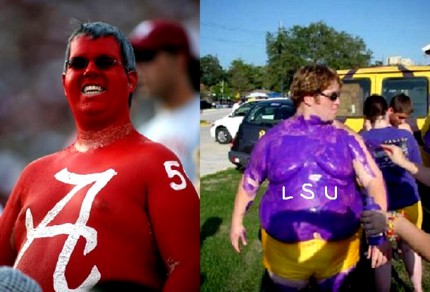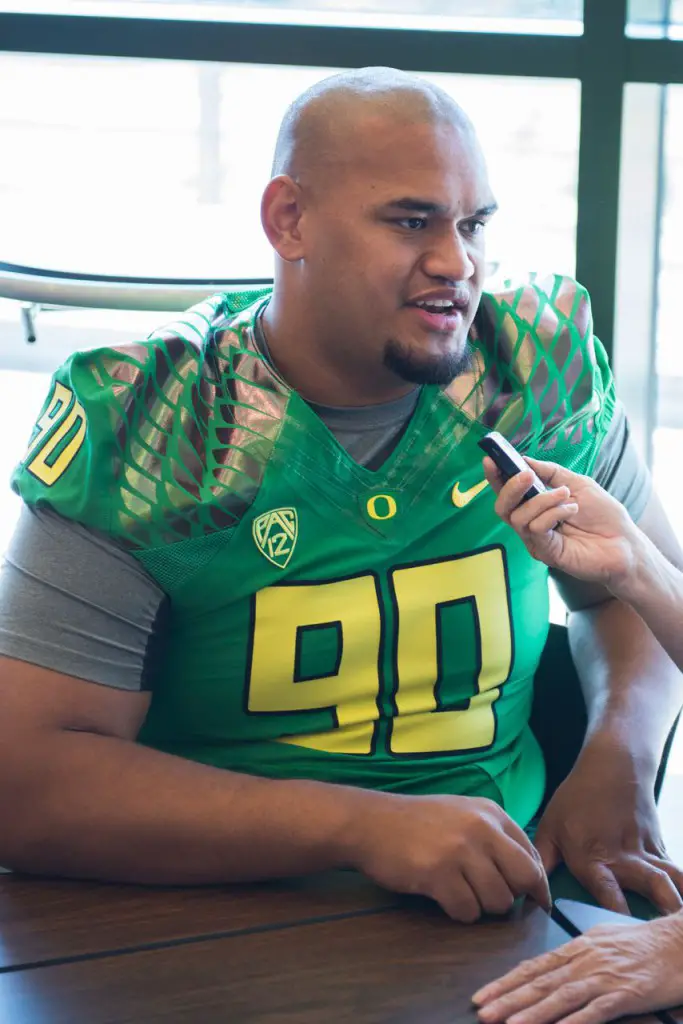A great man is always willing to be little. Ralph Waldo Emerson
Zach Okun isn’t the future of Oregon football — he’s the now. All 6’4″, 315 pounds of him. The Newbury Park, California, high school junior decided to end his recruitment process almost a year in advance of national signing day for the Class of 2015. In the time it took him to reach the Eugene airport, once he’d made the announcement on Twitter that he was going to Oregon, more than 40 college coaches lit up his smartphone, trying to change his mind. Schools that include USC, Notre Dame, Miami, Arizona, and Mississippi State are apparently out of luck.
Young Okun’s commitment to the Ducks is a sign of what is quietly happening at the moment in Eugene, as well as a harbinger of things to come. The inescapable fact seen is that the Ducks’ brain-trust is not, as some critical fans would have it, brain-dead. They understand that to get over that final hump, to take those last few steps onto the lofty summit that is a national championship, they need to stay faster and stronger than the college competition — and get a little bigger.
I give you Zach Okun.
Or, maybe, just maybe, the player Rivals rank as the No. 1 kid in the nation’s 2015 class, defensive end Byron Cowart, said to also be leaning toward becoming a Duck. As a junior, the Armwood, Florida, product racked up 72 tackles and 13 sacks, either blowing past or bowling over opposing linemen with frightening ease.
If Cowart does become a Duck (keep your eyes peeled on Nike’s ”The Opening” this week, where Cowart will be strutting his stuff and checking out what it feels like to play in something less than 100% humidity), he’ll have left the Alabamas, Floridas, and Clemsons of the collegiate football world at the altar.
“OK, whatever,” you may be thinking. Fact is the Ducks are, in the end, all about fast and slick. When push comes to shove — or in games against the likes of big, beefy teams like ‘Bama, Stanford, or Michigan State, when push comes to stuff — the smaller Ducks are inevitably worn down to a frazzle, analogous to the seemingly uncatchable roadrunner finally beaned by a bulky boulder.
Well, that was, for the sake of argument, then. So back to now. For the sheer fun of it, I decided to do a bit of highly unscientific data collecting. I zeroed in on the official 2014 rosters of the Ducks, the Alabama Crimson Tide, and the Michigan State Spartans. I specifically looked at each team’s respective offensive and defensive lines. I made no attempt to separate first- from third-stringers. Nor did I include defensive ends, tight ends, linebackers or defensive backs. Just guards, tackles, and centers on offense and interior DLs.
What I found is fascinating. On the offensive line, Michigan State lists 10 players, the largest of whom, Benny McGowan, tips the scales at 319 pounds. As a group, the Spartans weigh in at 3,852 pounds. Alabama’s roster features 13 offensive linemen, led (at least at the dinner table) by the gargantuan Brandon Hill — all 385 pounds of him. Collectively, the Crimson Tide total 4,081 pounds, roughly the weight of a stripped down Ford F-150 pickup.
Then we have the Ducks. As you know, the Chip Kelly/Mark Helfrich/Scott Frost approach to offensive football makes perfect sense, given that they’re coaching in a town officially branded as Track Town USA. One of their freshmen wide receivers, Devon Allen, just won the national championship in the 110-meter hurdles. The guy who won the 2013 world championship finished third. Remember, Allen’s a freshman.
Obviously an offense that features players such as Allen, fleet-footed Heisman candidate Marcus Mariota, and hyper-speed running backs such as Byron Marshall and Thomas Tyner had better have some linemen that can get up and run a bit themselves. So goodbye enormous, SEC-style paunches, and hello relatively lean muscle mass. Just to be safe, it’s probably a good idea to have enough bodies on hand so they can be platooned during a game, coming at the opposition in fresh waves. Ever been to the Oregon coast? Who’s winning, the sand dunes or the Pacific Ocean?
Which is why the Ducks list 20 (that’s twenty) offensive linemen on their 2014 roster, with Everett Benyard the biggest, at 305 pounds. As a group, they total a whopping 5,981 pounds. That’s 1,900 pounds more than Alabama, and a jaw-dropping 2,129 pounds more than Sparty. By the way, the Ducks also have recent signees Haniteli Louisi (OG, 295), Tyrell Crosby (OT, 290), Davis Miyashiro-Saipaia (OT, 285), and Braden Eggert (OT, 305) joining the fray this season. Add to that current 2015 verbal commitments from Brady Aiello (OT, 270), Calvin Throckmorton (OL, 270), Jake Hanson (OL, 285), and the aforementioned Okun (think these youngsters are going to shrink over the next year or two?), and the cavalry isn’t coming, folks, it has arrived.
So what about defense? Here, the Ducks are far more balanced. Having said that, because of their propensity to score quickly — and often — it would be logical to err on the side of down linemen who are above all, fit. And back them up with tough, aggressive defensive ends, linebackers and defensive backs, which the Ducks have done, and continue to do.
On the defensive side of the ball, Alabama sports nine linemen, with Darren Lake tipping the scales at 324 pounds. As a group, the Crimson Tide’s defensive linemen come in at 2,609 pounds. Michigan State also lists nine defensive linemen, topped by 308-pound Devyn Salmon. Together, the biggest of the Spartan defensive corps total 2,548 pounds. Back in Eugene, Oregon’s heaviest defensive lineman is Ricky Heimuli, at 321 pounds (that’s right, bigger than the heftiest defensive player in Tuscaloosa). Joined by seven teammates, the Ducks’ middle defensive unit totals 2,187 pounds. That’s 381 pounds lighter than their counterparts at Michigan State, and 422 pounds lighter than the ‘Bama boys. Gaps, yes, but certainly not as glaring as the ones that exist between the Oregon offensive unit, en masse, and their fellow elite gridiron adversaries.
So there you go. One man’s perhaps slightly provocative perspective on the perceived size gap between Oregon and the types of big, bad, smashmouth teams that have occasionally proved the Ducks’ undoing in the recent past. I suspect Coach Helfrich and his staff recite that Emerson quote with tongues firmly in cheek these days. When it comes to size, in a general sense at least, Oregon appears to be walking softly, while carrying an awfully big stick — one that’s getting bigger all the time.
Featured image courtesy of Zach Okun
Related Articles:
Chip Kelly Update: Everything's Good Again ...
Chip Kelly Update: Wailing and Gnashing of Teeth
Shock and Awe -- The Oregon Ducks' Football Hangover Effect
Despite Lopsided Score, Georgia State "Never Stopped Believing"
Hope Springs Eternal for Ducks
Incompetent Pac-12 Officials: How Do You Miss ALL of THIS?
Randy Morse (Editor and Writer) is a native Oregonian, a South Eugene High and U of O grad (where he played soccer for the Ducks, waaay back in ’70-‘71). After his doctoral work at the University of Alberta he launched a writing & publishing career – that plus his love of mountaineering has taken him all over the world. An award-winning artist, musician, broadcaster, and author, he’s written 8 books – his writing on media & democracy earned him the Friends of Canadian Broadcasting’s 2014 Dalton Camp Award. He swears he taught LaMarcus Aldridge his patented fade-way jump shot, and is adamant that if he hadn’t left the country (and was a foot taller) he would be the owner of a prosperous chain of fast food outlets and a member of the NBA Hall of Fame by now. If there is a more rabid Ducks fan in the known universe, this would come as a major surprise to Morse’s long-suffering family. He resides in the tiny alpine village of Kaslo, British Columbia.

